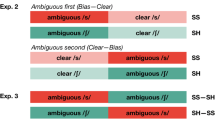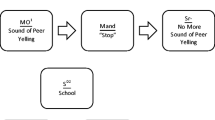Abstract
Beattie and Bradbury (1979) reported a study in which, in one condition, they punished speakers when they produced silent pauses (by lighting a light they were supposed to keep switched off). They found speakers were able to reduce silent pauses and that this was not achieved at the expense of reduced overall speech rate. They reported an unexpected increase in word repetition rate. A recent theory proposed by Howell, Au-Yeung, and Sackin (1999) predicts that the change in word repetition rate will occur on function, not content words. This hypothesis is tested and confirmed. The results are used to assess the theory and to consider practical applications of this conditioning procedure.
Similar content being viewed by others
REFERENCES
Arnoff, M. (1976). Word formation in generative grammar. In L. J. Morgan and K. Demuth (Eds.), Signal to syntax: Bootstrapping from speech to grammar in early acquisition. Mahwah, NJ: Erlbaum.
Au-Yeung, J., Howell, P., & Pilgrim, L. (1998). Phonological words and stuttering on function words. Journal of Speech, Language, and Hearing Research, 41, 1019-1030.
Beattie, G. W., & Bradbury, R. J. (1979). An experimental investigation of the modifiability of the temporal structure of spontaneous speech. Journal of Psycholinguistic Research, 8, 225-248.
Blackmer, E. R., & Mitton, J. L. (1991). Theories of monitoring and the timing of repairs in spontaneous speech. Cognition, 39, 173-194.
Bloom, L. (1970). Language development: Form and function in emerging grammars. Cambridge, MA: MIT Press.
Bock, K., & Levelt, W. (1994). Language production: Grammatical encoding. In M. Gernsbacher (Ed.), Handbook of Psycholinguistics (pp. 945-978). San Diego, CA: Academic Press.
Brown, R. (1973). A first language: The early stages.Cambridge, MA: Harvard University Press.
Brown, S. F. (1945). The loci of stutterings in the speech sequence. Journal of Speech Disorders, 10, 182-192.
Butterworth, B. (1975). Hesitation and semantic planning in speech. Journal of Psycholinguistic Research, 1, 75-78.
Caramazza, A., & Miozzo, M. (1997). The relation between syntactic and phonological knowledge in lexical access: evidence from the “tip-of-the-tongue” phenomenon. Cognition, 64, 309-343.
Clark, H. H., & Clark, E. (1977). Psychology and language. An introduction to psycholinguistics.New York: Harcourt.
Dell, G. S. (1986). A spreading-activation theory of retrieval in sentence production. Psychological Review, 93, 283-321.
Gee, J. P., & Grosjean, F. (1983). Performance structures: A psycholinguistic and linguistic apprasial. Cognitive Psychology, 15, 411-458.
Goldman-Eisler, F. (1972). Pauses, clauses, sentences. Language and Speech, 15, 103-113.
Hartmann, R. R. K., & Stork, F. C. (1972). Dictionary of language and linguistics. London: Applied Science.
Howell, P., Au-Yeung, J., & Sackin, S. (1999). Exchange of stuttering from function words to content words with age. Journal of Speech, Language and Hearing Research, 42, 345-354.
Howell, P., Au-Yeung, J., & Sackin, S. (2000). Internal structure of content words leading to lifespan differences in phonological difficulty in stuttering. Journal of Fluency Disorders, pp. 1-20.
Howell, P., Sackin, S., & Glenn, K. (1997). Development of a two-stage procedure for the automatic recognition of dysfluencies in the speech of children who stutter. I. Psychometric procedures appropriate for selection of training material for lexical dysfluency classifiers. Journal of Speech, Language and Hearing Research, 40, 1073-1084.
Kucera, H., & Francis, N. (1967). A computational analysis of present day English.Providence, RI: Brown University Press.
Landau, B., & Jackendoff, R. (1993). “What” and “where” in spatial language and spatial cognition. Brain and Behavioral Sciences, 16, 217-265.
Levelt, W. J. M. (1992). Accessing words in speech production: Stages, processes, and representations. Cognition, 42, 1-22.
Miozzo, M., & Caramazza, A. (1997). Retrieval of lexical-syntactic features in tip-of-thetongue states. Journal of Experimental Psychology: Learning, Memory, and Cognition, 23, 1410-1423.
Onslow, M., Packman, A., Stocker, S., Van Doorn, J., & Siegel, G. M. (1997) Control of children's stuttering with response-contingent time-out: Behavioral, perceptual, and acoustic data. Journal of Speech, Language, and Hearing Research, 40, 121-133.
Pinker, S. (1995). Language acquisition. In L. R. Gleitman, M. Liberman, & D. N. Osherson (Eds.), An Invitation to Cognitive Science, 2nd edn. Vol. 1: Language. Cambridge, MA: MIT Press.
Quirk, R., Greenbaum, S., Leech, G., & Svartvik, J. (1985). A comprehensive grammar of the English language. London: Longman.
Radford, A. (1990). Syntactic theory and the acquisition of English syntax. Oxford: Basil Blackwell.
Sander, E. K. (1972). When are speech sounds learned? Journal of Speech and Hearing Disorders, 37, 55-63.
Selkirk, E. (1984). Phonology and syntax: The relation between sound and structure. Cambridge, MA: MIT Press.
Sternberg, S., Monsell, S., Knoll, R. L., & Wright, C. E. (1978). The latency and duration of rapid movement sequences: Comparison of speech and typewriting. In G. E. Stelmach (Ed.), Information processing in motor control and learning.New York: Academic Press.
Strenstrom, A.-B., & Svartvik, J. (1994). Imparsable speech: Repeats and other nonfluencies in spoken English. In N. Oostdijk & P. de Haan (Eds.), Corpus-based research into language. Atlanta, GA: Rodopi Amsterdam.
Wingfield, A. (1968). Effects of frequency on identification and naming of objects. American Journal of Psychology, 81, 226-234.
Author information
Authors and Affiliations
Rights and permissions
About this article
Cite this article
Howell, P., Sackin, S. Function Word Repetitions Emerge When Speakers Are Operantly Conditioned to Reduce Frequency of Silent Pauses. J Psycholinguist Res 30, 457–474 (2001). https://doi.org/10.1023/A:1010432012241
Issue Date:
DOI: https://doi.org/10.1023/A:1010432012241




